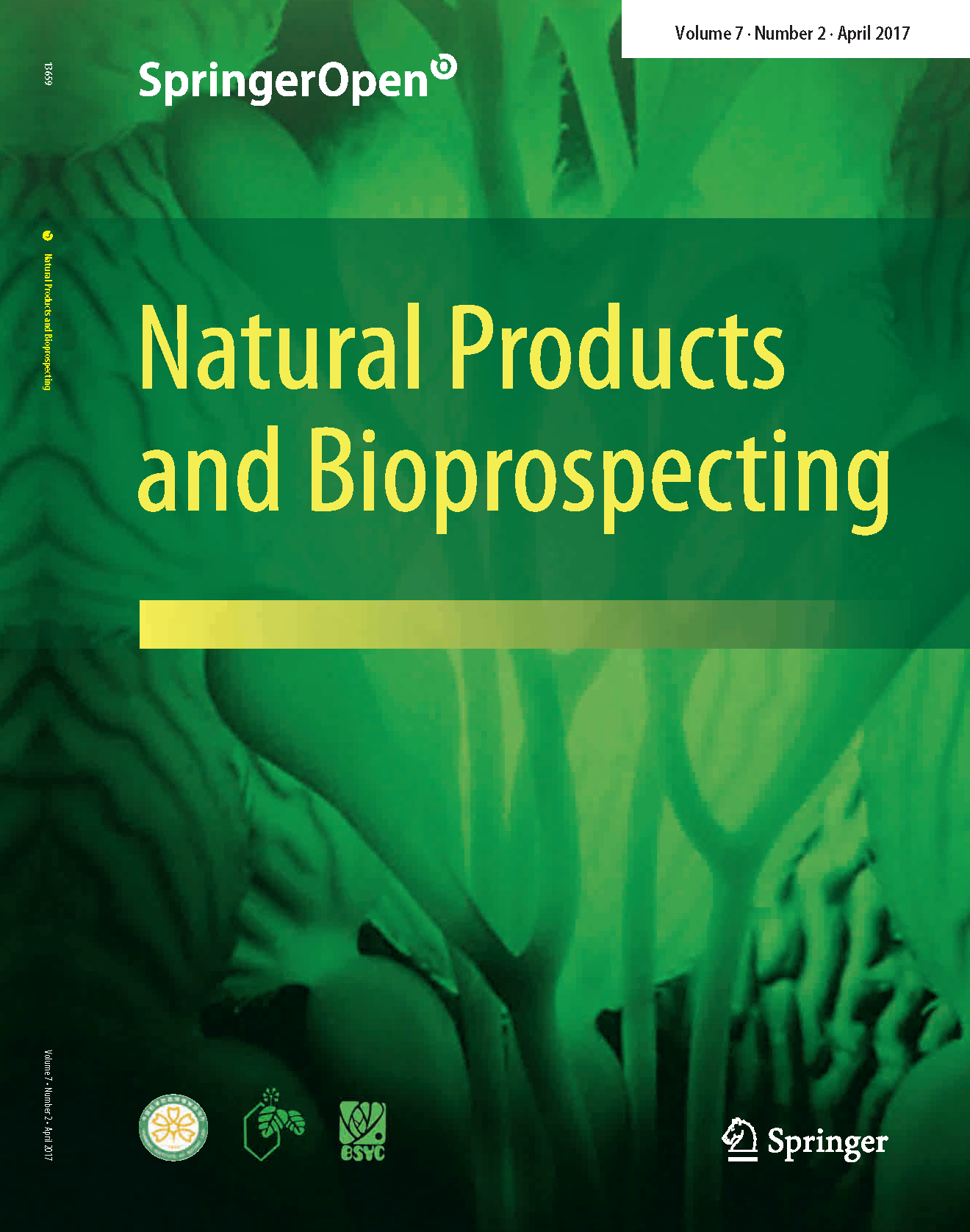|
|
The Genus Carissa: An Ethnopharmacological, Phytochemical and Pharmacological Review
Collect
Joseph Sakah Kaunda, Ying-Jun Zhang
Natural Products and Bioprospecting. 2017, 7 (2): 181-199.
DOI: 10.1007/s13659-017-0123-0
Carissa L. is a genus of the family Apocynaceae, with about 36 species as evergreen shrubs or small trees native to tropical and subtropical regions of Africa, Asia and Oceania. Most of Carissa plants have been employed and utilized in traditional medicine for various ailments, such as headache, chest complains, rheumatism, oedema, gonorrhoea, syphilis, rabies. So far, only nine Carissa species have been phytochemically studied, which led to the identification of 123 compounds including terpenes, flavonoids, lignans, sterols, simple phenolic compounds, fatty acids and esters, and so on. Pharmacological studies on Carissa species have also indicated various bioactive potentials. This review covers the peerreviewed articles between 1954 and 2016, retrieved from Pubmed, ScienceDirect, SciFinder, Wikipedia and Baidu, using "Carissa" as search term ("all fields") and with no specific time frame set for search. Fifteen important medicinal or ornamental Carissa species were selected and summarized on their botanical characteristics, geographical distribution, traditional uses, phytochemistry, and pharmacological activities.
References |
Related Articles |
Metrics
|
|
|
Polysubstituted Isoflavonoids from Spatholobus suberectus, Flemingia macrophylla, and Cudrania cochinchinensis
Collect
Li-Xia Wang, Hai-Rong Zheng, Fu-Cai Ren, Tian-Ge Chen, Xiang-Mei Li, Xian-Jun Jiang, Fei Wang
Natural Products and Bioprospecting. 2017, 7 (2): 201-206.
DOI: 10.1007/s13659-017-0121-2
Four hitherto unknown polysubstituted isoflavonoids, including three isoflavans:7,4'-dihydroxy-8,2',3'-trimethoxyisoflavan (1), 7,2',4'-trihydroxy-8,3'-dimethoxyisoflavan (2), and 7,2',4'-trihydroxy-5-methoxyisoflavan (3), and one prenylated isoflavone cudraisoflavone M (4) were isolated from the ethanol extracts of Spatholobus suberectus (for 1 and 2), Flemingia macrophylla (for 3), and Cudrania cochinchinensis (for 4), respectively. Their structures were established on the basis of extensive spectroscopic analysis. Compounds 1 and 4 exhibited weak cytotoxic activity against five human cancer cell lines (HL-60, A-549, SMMC-7721, MCF-7, and SW-480).
References |
Related Articles |
Metrics
|
|
|
Otophylloside B Protects Against Aβ Toxicity in Caenorhabditis elegans Models of Alzheimer's Disease
Collect
Jie Yang, Xiao-Bing Huang, Qin-Li Wan, Ai-Jun Ding, Zhong-Lin Yang, Ming-Hua Qiu, Hua-Ying Sun, Shu-Hua Qi, Huai-Rong Luo
Natural Products and Bioprospecting. 2017, 7 (2): 207-214.
DOI: 10.1007/s13659-017-0122-1
Alzheimer's disease (AD) is a major public health concern worldwide and the few drugs currently available only treat the symptoms. Hence, there is a strong need to find more effective anti-AD agents. Cynanchum otophyllum is a traditional Chinese medicine for treating epilepsy, and otophylloside B (Ot B), isolated from C. otophyllum, is the essential active component. Having previously identified anti-aging effects of Ot B, we evaluated Ot B for AD prevention in C. elegans models of AD and found that Ot B extended lifespan, increased heat stress-resistance, delayed body paralysis, and increased the chemotaxis response. Collectively, these results indicated that Ot B protects against Aβ toxicity. Further mechanistic studies revealed that Ot B decreased Aβ deposition by decreasing the expression of Aβ at the mRNA level. Genetic analyses showed that Ot B mediated its effects by increasing the activity of heat shock transcription factor (HSF) by upregulating the expression of hsf-1 and its target genes, hsp-12.6, hsp-16.2 and hsp-70. Ot B also increased the expression of sod-3 by partially activating DAF-16, while SKN-1 was not essential in Ot B-mediated protection against Aβ toxicity.
References |
Related Articles |
Metrics
|
|
|
Synthesis and Cytotoxicity Evaluation of Tropinone Derivatives
Collect
Xiu-Juan Yin, Chang-An Geng, Xing-Long Chen, Chang-Li Sun, Tong-Hua Yang, Tian-Ze Li, Jun Zhou, Xue-Mei Zhang, Ji-Jun Chen
Natural Products and Bioprospecting. 2017, 7 (2): 215-223.
DOI: 10.1007/s13659-017-0124-z
Sixteen tropinone derivatives were prepared,and their antitumor activities against five human cancer cells (HL- 60,A-549,SMMC-7721,MCF-7 and SW480) were evaluated with MTS[3-(4,5-dimethylthiazol-2-yl)-5-(3-carboxy methoxyphenyl)-2-(4-sulfopheny)-2H-tetrazolium]assay.Most of the derivatives exhibited better activities compared with tropinone at the concentration of 40 lM.Particularly,derivative 6 showed significant activities with IC50 values of 3.39, 13.59,6.65,13.09 and 12.38 μM respectively against HL-60,A-549,SMMC-7721,MCF-7 and SW480 cells,which suggested more potent activities than that of cis-dichlorodiamineplatinum (DDP).
References |
Related Articles |
Metrics
|
|

